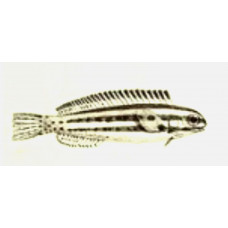Latin name
Meiacanthus anema
Other name
Meiacanthus anema
Identification
Presence of poisonous cheek glands associated with grooved canines.
Features of fish fins
Dorsal spines (total): 6-10; Dorsal soft rays (total): 20-24; Anal spines: 2; Anal soft rays: 16-19.
Fish colouring
A gray fish with a light longitudinal stripe.
Distribution
Asia and Oceania: Indonesia, Philippines, New Guinea, Solomon Islands and New Hebrides, Vanuatu. Reported from New Caledonia.
Habitat
Marine tropical freshwater brackish demersal amphidromous species. Depth range from 0 to 10 meters.
Size
Reach a length of 7.2 centimeters (2.8 inches).
Behavior
Adults are found in estuaries and freshwater habitats, often where mangroves are abundant. Larvae are planktonic, often found in shallow coastal waters.
Food and feeding habits
Feeds primarily on plankton.
Reproduction
Egg-laying. Clearly marked mating. Eggs are bottom-glued and attached to the substrate.
Fishing
Fished for sale to aquariums.
Relationship with a person
This poisonous species can be found in the aquarium trade.
| Classification | |
| Phylum | Chordata |
| Class | Actinopterygii |
| Squad | Blenniiformes |
| Family | Blenniidae |
| Genus | Meiacanthus |
| Species | M. anema |
| Features | |
| Conservation status | Least Concern |
| Habitat | Bottom |
| Life span, years | No information |
| Maximum body weight, kg | No information |
| Maximum length, cm | 7,2 |
| Sailing speed, m/s | No information |
| Threat to people | Not edible |
| Way of eating | Predator |
Threadless blenny
Tags: threadless blenny

